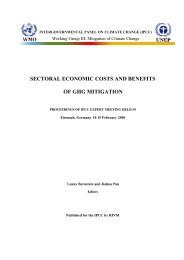Pacific Islands Environment Outlook - UNEP
Pacific Islands Environment Outlook - UNEP
Pacific Islands Environment Outlook - UNEP
Create successful ePaper yourself
Turn your PDF publications into a flip-book with our unique Google optimized e-Paper software.
xi<br />
Introduction<br />
The <strong>Pacific</strong> islands region is unique, not because its<br />
geographical, biological, sociological and economic<br />
characteristics are found exclusively here, but because of<br />
the combination of these characteristics within the<br />
region. It occupies a vast 30 million km 2 of the <strong>Pacific</strong><br />
Ocean, which is an area more than three times larger<br />
than the United States of America or China (SPREP<br />
1992). This region is characterized by: small land masses<br />
dispersed over 5.8 per cent of the Earth’s surface; a high<br />
degree of ecosystem and species diversity; an<br />
extraordinary level of endemicity; a high degree of<br />
economic and cultural dependence on the natural<br />
environment; vulnerability to a wide range of natural and<br />
environmental disasters, and a diversity of cultures and<br />
languages, traditional practices and customs focused on<br />
the marine and coastal environment.<br />
The 22 countries and territories of the <strong>Pacific</strong> islands<br />
region consist of approximately 550 000 km 2 of land with<br />
7.5 million inhabitants. If Papua New Guinea is excluded,<br />
the figures drop to 87 587 km 2 of land and 2.7 million<br />
people (SPC 1998). Geographically, the region extends<br />
from Pitcairn in the east to Papua New Guinea in the<br />
west. The region is home to a variety of peoples and<br />
cultures, with three commonly recognized subregional<br />
constituents – Micronesia, Polynesia and Melanesia.<br />
More than 2 000 different languages are spoken across<br />
the region (Thistlethwaite and Votaw 1992).<br />
The countries and territories that make up the<br />
<strong>Pacific</strong> islands region are listed in Figure 0.1 on the<br />
following page.<br />
Whilst the region is diverse in terms of the size and<br />
features of its member countries and territories, there<br />
are some common characteristic features (SPREP 1992;<br />
Thistlethwaite and Votaw 1992; SPREP/ESCAP 1996).<br />
●<br />
●<br />
●<br />
Geographical isolation: The large volumes of water<br />
and small areas of land create an environment that is<br />
relatively isolated on a global scale. Whilst in the<br />
past this has had benefits from an ecological<br />
perspective, it also provides challenges; for example,<br />
travel both within member countries and on a<br />
regional level can be difficult.<br />
Fragility of the environment: Geographical and<br />
ecological isolation has led to the evolution of<br />
unique species and communities of plants and<br />
animals, many of which are indigenous to only one<br />
island or island group within the region. Changes to<br />
land use, population, consumption and other<br />
determinants of environmental well-being make the<br />
<strong>Pacific</strong> island habitats particularly vulnerable to<br />
destruction or damage.<br />
Rapid population growth: In the past century most<br />
<strong>Pacific</strong> island countries (PICs) have experienced<br />
rapid population growth. This population growth,<br />
along with the increasing commercialization of<br />
subsistence-based economies, has been associated<br />
with rapid increases in rates of natural resource<br />
exploitation, especially of land, forests and fisheries.<br />
While population growth throughout the region is<br />
beginning to slow, there is concern that populations

















